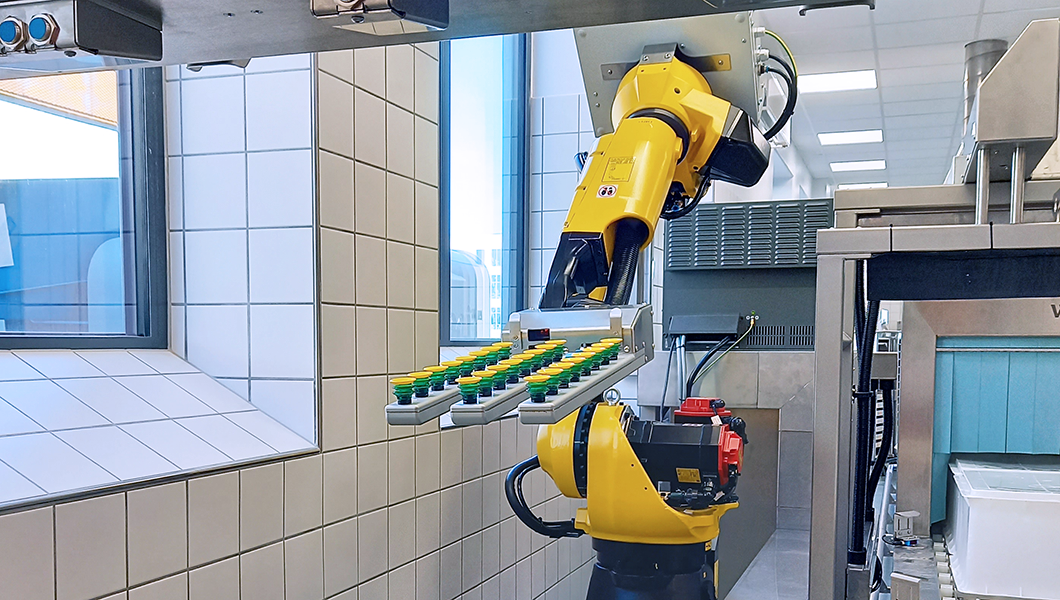A lot of automation has been planned for the workflows at Nyt OUH. Here, it is the kitchen robot Rob-Otto that empties the food carts and places trays and containers at the washing machine.
It is progressing with the construction of New OUH, Region Southern Denmark’s super hospital. The same applies to automation solutions, which must make flows more efficient and work procedures gentler for the employees.
At Nyt OUH, they have chosen to gather all service functions for the hospital in the so-called Service City. The service city will house the many service departments that help every day to ensure that patients and employees at the hospital itself have everything they need to make treatments, operations, bed wards, day wards and everything else work smoothly.
In Servicebyen, the project management at Nyt OUH has looked at how to create the most efficient and gentle work processes for the benefit of everyone. Here, automation solutions are the answer, and Gibotech has been chosen as a supplier for several of them. One of the automation solutions is already in use, another has reached the testing phase and can soon be handed over, while the third is being programmed.
Automated Sterile Processing Department
The Sterile Processing Department (SPD) at Nyt OUH will be fully automated. This means that virtually all the manual processes that can be standardized will be carried out by robots and other technological solutions.
Robots will handle – open and empty – case carts that come into the SPD with used surgical instruments. Roller and wheel conveyors respectively transport case carts and containers with the instruments onto the respective areas, where the case carts are washed and the instruments are cleaned and checked.
The cleaned and sterilized surgical instruments will be stored in the large sterile buffer. The instruments are packed manually in containers so that they are ready for operations. They are then taken via roller conveyors into the sterile warehouse, where a storage robot places the container on a free shelf. Because the software keeps track of which instruments are on which shelves, all free shelves can be used. When instruments are to be used for an operation, the robot retrieves the respective container, and the roller conveyors take it out from the sterile warehouse.
The kitchen robot Rob-Otto
The kitchen in Servicebyen has already been put into operation. The kitchen is currently supplying food to the current Odense University Hospital until the new super hospital is ready.
In the kitchen, many of the previously manual flows have been automated. Therefore, the employees do not have to, for example, drive food trucks from the laundry room to the cold room. And they don’t have to empty the food carts themselves either; a one-sided and repetitive process, which can cause crooked twists in the body.
That task has been taken over by Rob-Otto, the kitchen robot. The food truck is driven to the robot, where sensors register which type of food truck it is. After this, Rob-Otto makes sure to empty the food cart. The robot starts from the bottom and moves up until a tray is detected. Suction cups hold the tray in place while the robot lifts the tray over to the washing machine. Here, the trays are placed at the top of the washing machine, while food storage trays and the like are turned upside down and placed on the conveyor belt into the washing machine itself.
The logistics system is being tested
A logistics system must both connect the individual departments in the Service City and also ensure the transport of material from the Service City to the respective departments in the hospital.
The logistics system in Servicebyen is now installed and ready to be programmed. The system consists of approximately eight kilometres of roller conveyors and is integrated into over 30 building parts. It is, for example, waste, linen, goods and operation equipment, which must be transported from the hospital and to the correct department in the Service City – for example, the Central Sterile Supply Department – or internally in the Service City; for example from the goods reception and to the laundry.
Automation benefits employees and patients
Automating workflows can seem complex, and there is also a good deal of preparatory work before the system runs as it should.
But the benefits of automating outweigh the work involved.
Many of the repetitive work tasks that wear out the employees’ bodies are removed. Twisting, lifting and undesirable working postures; for example with the hands above shoulder height for a long time when trolleys have to be pushed around.
Instead, the employees can use the time to solve the patient-related tasks, quality control or solve the tasks where it is an advantage to have a set of human eyes and hands. For example, in the Central Sterile Supply Department, where instruments must be checked to ensure that they are still functional.
In addition, workflows become more efficient. The robots and the other automation solutions do exactly the task they are programmed for. They do not go for a lunch break or suddenly leave to attend to another task. This means that there is a continuous flow in the work so no bottlenecks are created.
Sign up for our newsletter
How can you automate in a hospital? Sign up for our newsletter for hospitals and get news and inspiration.
Contact us
Address
5220 Odense SØ
Denmark
Contact
+ 45 65 95 82 62
gibotech@gibotech.dk
Opening hours
Friday: 7.00 – 13.00
